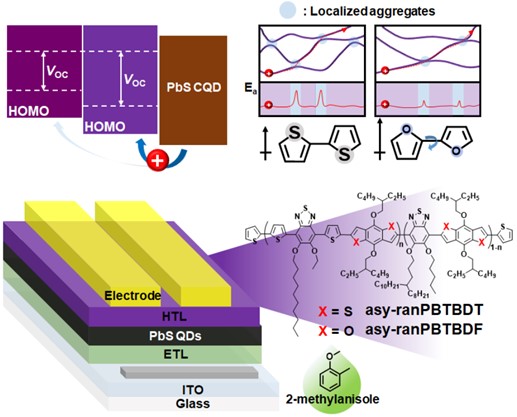
연구
Research Outcome
미래를 창조하는 포스텍 화학공학과
A Furan-Substituted Polymeric Hole-Transporting Material for Energy Level Regulation and Less Planarity in Colloidal Quantum Dot Solar Cells
- Title of paper
- A Furan-Substituted Polymeric Hole-Transporting Material for Energy Level Regulation and Less Planarity in Colloidal Quantum Dot Solar Cells
- Author
- [박태호 교수 연구실] 콜로이드 양자점 태양전지에서의 에너지 준위조절 및 평면성 감소를 위한 퓨란기가 치환된 고분자 정공 수송층 개발
- Publication in journal
- Energy & Environmental Materials
- Publication date
- 20220418
[Abstract]
For efficient colloidal quantum dot (CQD) solar cells (CQD-SCs), thiol-passivated p-type CQDs are generally used as a hole-transporting material (HTM); however, there are issues with the control of optoelectrical properties, low thiol passivation rate, and poor morphology with a power conversion efficiency (PCE) of approximately 11%. Although polymeric HTMs have been introduced to address these issues, maximizing efficiency and achieving green-solvent processability and thermal stability for commercialization is necessary. Here, we synthesize a novel benzodifuran (BDF)-based HTM (asy-ranPBTBDF) showing an electron-deficient state, low steric hindrance, and low planarity compared to those of a typical benzodithiophene (BDT)-based HTM (asy-ranPBTBDT). BDF properties lead to deep high occupied molecular orbital (HOMO) levels, close π-π stacking, excellent solubility, and amorphous properties related to efficiency, green-solvent processability, and thermal stability. With these benefits, the asy-ranPBTBDF-based CQD-SC showed enhanced open-circuit voltage (VOC) (0.65 V) and PCE (13.29%) compared to those of the asy-ranPBTBDT-based device (0.63 V and 12.22%) in toxic processes with chlorobenzene. The asy-ranPBTBDF-based CQD-SC showed a PCE of 12.51% in a green-solvent process with 2-methylanisole and improved thermal stability at 80 °C (83.8% retaining after 24 h) owing to less lateral crystallization than the asy-ranPBTBDT-based device (60.8% retaining after 24 h).
DOI: https://doi.org/10.1002/eem2.12408
|
For efficient colloidal quantum dot (CQD) solar cells (CQD-SCs), thiol-passivated p-type CQDs are generally used as a hole-transporting material (HTM); however, there are issues with the control of o... doi.org |
Link: https://onlinelibrary.wiley.com/doi/abs/10.1002/eem2.12408





